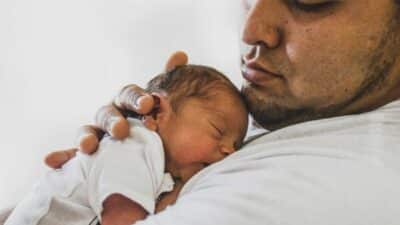Becoming pregnant after sterilization
Sterilization as a safe method of contraception
Sterilization should be a final decision when your desire to have children is complete or when you do not want to have children. Ultimalty, after this procedure you can no longer get pregnant naturally. What are the options for fulfilling your desire to have children after a sterilization?
How is female sterilization performed?
The most commonly performed method is cutting the fallopian tubes. The procedure can be performed on an outpatient basis through a small incision at the belly button. During laparoscopy, the fallopian tube is either electrically sclerosed, completely cut or closed with a clip. This prevents eggs from traveling through the fallopian tube and meeting sperm there.

Can a sterilization be reversed?
It cannot be said as a general rule that every sterilization can be reversed. However, within the framework of a microsurgical operation (refertilization), fertility can be restored under certain circumstances.
Child wish after sterilization: hope through refertilization
If fertility is to be restored, women can opt for refertilization. This is a surgical procedure that is intended to make the fallopian tubes functional again.
What are the requirements for refertilization?
Restoring a woman’s fertility only makes sense if she can still ovulate. Therefore, the age and also the oocyte reserve (measured by the AMH value) is decisive for whether a woman can become pregnant again. You can test your AMH level from the comfort of your own home with our self-test. In addition, the length of the fallopian tubes also plays a role. The two ends must add up to at least 4 cm for them to be surgically rejoined.
Refertilization procedure: How is the operation performed?
If you want to get pregnant again after sterilization, you will have to undergo a procedure under general anesthesia. The surgery is performed either minimally invasively through an incision at the level of the navel or abdominally through an abdominal incision. The separated ends of the fallopian tubes are rejoined and the scarred parts are removed. The suturing of the tissue is done step by step. At the end of the procedure, a permeability test of the fallopian tubes is performed.
Risks of refertilization
Risks of this procedure are mainly due to general anesthesia. In rare cases, thrombosis, inflammation of the abdominal cavity or secondary bleeding may occur. The risk of ectopic pregnancy is also higher after refertilization.
What are the chances of success with a refertilization?
If the test for tubal patency was successful, there is theoretically an immediate possibility of becoming pregnant again. However, the chances of success of a refertilization are reduced if there was a lot of scar tissue on the fallopian tubes. A 2017 study examined pregnancy rates after successful refertilization in 10686 women. The researchers found pregnancy rates ranging from 42% to 69% after refertilization.
Costs
The procedure to restore fertility is generally not covered by health insurance. Depending on the method (laparoscopy or abdominal incision), the cost of the procedure ranges from 2000 to 5000 euros.

Alternative to refertilization: artiticial insemination.
Sterilized women who want to become pregnant can achieve this by means of assisted reproduction (IVF or ICSI).
In this procedure, the woman’s fertilizable eggs are removed directly from the ovary, fertilized outside the body, and then reinserted into the uterus. In this way, the fallopian tubes are bypassed.
IVF (in vitro fertilization) and ICSI (intracytoplasmic sperm injection) differ in that in IVF the eggs are placed with the sperm in a test tube where, in the best case, they find each other independently. This is where the term “test tube fertilization” comes from. The fertilized eggs are then reinserted into the woman.
In ICSI, the doctor injects individual sperm into the retrieved female eggs using a micropipette. Fertilization takes place under a special microscope and can therefore be strictly controlled. If the procedure is successful, the fertilized eggs can be transferred into the woman’s body between two to six days after the puncture.
General anesthesia is not necessary for artificial insemination.
Here you will find all the important information about the different treatments, the procedure and the likelihood of success of assisted reproduction. Please have a look at our blog article!
You can also get a free and non-binding consultation from our patient advisors. Simply book an appointment here.
About Fertilly
At Fertilly, we have made it our mission to accompany couples (homosexual and heterosexual) and singles on the way to fulfilling their child wish. In doing so, it is important to us to create transparency in the area of fertility services, to provide information and knowledge on the topics of pregnancy and fertility and to help you to find the most suitable Fertility Center. Through cooperation with first-class Fertility Centres and clinics in Europe, enquiries about Fertilly are given preferential treatment. This means that our patients avoid the usually long waiting times and get appointments more quickly.
If you would like more information about Fertility Centers, success rates and prices, please contact us using this questionnaire. We will advise you free of charge and without any obligation.
-
Answer the first questions in the online form in order to book an appointment. This way we can better address your needs during the conversation.
-
We will find the best contact person for your individual needs. Schedule 20 minutes for the consultation.
-
We will introduce you to the right fertility clinic from our network, make an appointment and accompany you until your wish for a child is fulfilled.










